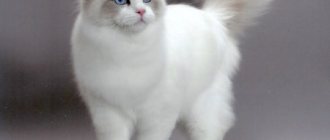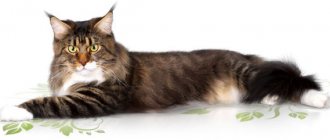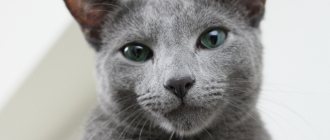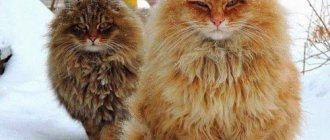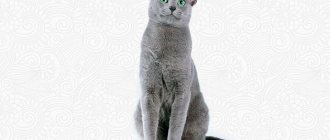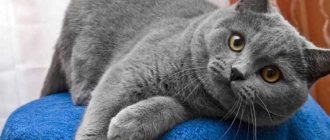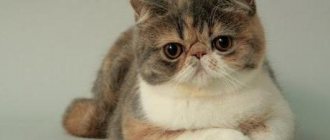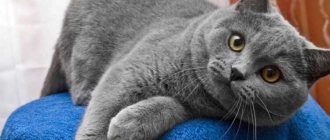The Turkish Angora has won the love of millions of cat lovers around the world. Amazingly soft skin, multi-colored eyes of unearthly beauty, a sense of one’s own greatness in the gaze, coupled with a dog’s loyalty. These are the reviews you can hear about this breed.
In order for an Angora cat to take root in the house and delight its owners with its presence for many years, you need to know everything about the breed: character, care features, congenital defects, as well as breeding features.
History of the origin of the breed
The Angora cat is the national pride of Turkey, because the breed first appeared in this country around the 16th century. The name was invented in honor of the former capital - the city of Ankara. The ancestors of four-legged cats were most likely Persian cats. Representatives of the cat family were brought to European countries from Turkey, mainly as gifts, which suggests that the Turkish Angora is not considered a purely indigenous breed. In Europe, animals immediately became favorites of royal and imperial palaces.
Angora kittens were considered prestigious pets, so only a select few could enjoy their presence in their homes. These graceful individuals with lush fur coats and almond-shaped eyes were received with honor in the Russian Empire. The German zoologist Bram described the breed in 1860 as the most beautiful of all existing ones. Soon, long-haired oriental beauties became popular and in demand all over the world, because almost all other members of the cat family were short-haired. In 1973 and 1978, the CFA registered the Angora as a breed of white and colored cats.
Interesting facts about the breed
The Turkish cat has many different interesting stories from her biography. There are many paintings from the 17th to 19th centuries depicting these animals. They were on the canvases of Bouchelier, Hayer, Ware and other artists of that time. This cat became the main character of Marshak’s work “Cat House”. Among the fans were many famous people, from Cardinal Reshelier to poets, artists, and fashion designers.
Adult cat
Turkish Angora cat - description of the breed
The Angora cat is one of the most graceful, elegant and poised pets that can win everyone's heart with its silky soft fur, long slender body, smoothly pointed ears and large bright eyes. Those who have decided to acquire such a four-legged friend should familiarize themselves in more detail with the characteristics and standards of this breed.
Appearance
Angoras have a medium-sized, muscular body and thin, silky fur that shimmers in the light when moving. The physique of males and females is different: the body of females is more elongated, the head is small and graceful. On the contrary, the body of cats is shortened, the head is large. The weight of four-legged animals ranges from 2.5-5 kg, with “boys” being noticeably larger than “girls”. The life expectancy of representatives of the Turkish breed is 12-15 years, and some individuals live up to 20 years.
Body structure
Looking at a representative of the breed, you get the impression that you are looking at a model walking along the catwalk - the animal has an elongated, thin body, long, dry, but muscular legs. The hind limbs are slightly longer than the forelimbs. A distinctive feature of the Angora, which gives the beauty a special elegance and beauty, is the tail - it is much longer than that of other cats. The tail is fluffy, with long thick hair, reminiscent of a peacock.
Angora cats have a narrow head, a wedge-shaped muzzle, and a small skull. The animal has an elegant neck of medium length, which goes into a slender body. The ears are located close to each other, pointed at the tips, and are large in size. The Turkish beauty's nose is long, smooth, without humps. The cheekbones are set high, but they are not too pronounced.
Coat and color
The fur coat of representatives of the breed is silky and soft to the touch, and has a minimal amount of undercoat. Turkish Angoras “wear” a shirtfront around their necks, and their hind legs are decorated with oriental “harem pants.” Traditionally, pets have long hair, and reviews from owners of such cats prove that they practically do not shed. The coat is smooth throughout the body, but may be wavy on the belly.
White was the traditional color of Angoras. Today, in addition to the Siamese, chocolate or lilac color, indicating the presence of a gene from another breed, the standard also provides for other color options:
- black – the coat color is solid black, the skin and paw pads are also black. Stains and any overflow are unacceptable;
- blue. The color is characterized by a uniform bright color of the coat. The nose and paw pads are blue;
- beige - wool of a single cream color;
- Calico is a multi-colored coat in which white is predominant.
Eye color
The eyes of the Turkish beauty are large, expressive, and slightly askew. They can be of any color: gray, blue, red and gold are acceptable, while deep, uniform shades are preferred. Particularly valuable are the odd-eyed individuals. Studies conducted by felinologists have shown that the main color of the animal does not in any way affect the color of the eyes.
- Tax breaks for retirees in 2022
- Refrigerator seal - signs of damage or wear, repair and replacement at home
- When is the best time to take vitamins?
Appearance of the breed
Angora is a breed of semi-longhaired cat without undercoat. The graceful and flexible Turkish female is small, 30 cm in height, weighing about 4 kg (males reach 6 kg).
According to accepted standards, Angora has the following characteristics:
- The body is toned, with dry and developed muscles;
- The coat is thin, thick, and has a collar on the neck. It is thicker on the belly and hind legs;
- The tail is fluffy and long, slightly tapering towards the tip;
- The ears are large and erect. Inside with wool, there are tassels at the ends;
- The eyes are a little slanted. Large, almond-shaped. The Russian Angora has green eyes. Kittens with different eye colors are more valuable;
- Limbs - long and slender, elastic muscles. The photo of the Turkish Angora shows how elegant its fluffy “pants” look. The front legs are slightly shorter than the hind legs;
- The head is wide, pointed towards the bottom.
Character and habits
An Angora cat is an ideal pet for a calm, inactive person who will be happy to spend evenings at home, holding a purring creature on his lap. Nature has endowed the Turkish beauty with a playful and cheerful character and devotion to her owner. Although the kitty loves to lie down, she cannot be called lazy: as soon as there is a ball or something rustling on the floor, she will immediately start playing.
Representatives of the Angora breed are considered predators, so if the animal ends up in a private house in the village, it will easily catch all the rats and mice. Cats living in apartments and not having the opportunity to hunt rodents will be happy to catch furry mice, rustling candy wrappers, and play with belts or objects tied to a string.
The Angora cat loves heights very much, so it easily climbs wherever it wants: living in a private sector, it walks on the roofs of buildings, climbs trees. Pets kept in an apartment have to climb onto cabinets, climb door frames or curtains, and kittens have to climb the legs of chairs and tables. The favorite resting place of every angora is the highest closet or mezzanine.
Angoras behave well with any children (human or their own), showing care and affection. As soon as the baby starts crying, she will immediately react - she will begin to purr, rub herself, lick off her tears and console him in every possible way. Having such a fluffy “nanny”, it is better not to shout at the child - the protector can scratch her little friend’s offender until he bleeds.
Representatives of the breed are sensitive, so they are able to react “correctly” even to the sounds of music: when a sad melody plays, the animal purrs plaintively in an undertone, cheerful notes encourage it to play actively. Thanks to their sociability and friendliness, pets find a common language with new people in the owner’s house: after sniffing the stranger, they climb into his arms, demanding affection.
Advantages of an Angora cat
Representatives of the Turkish cat breed have very few disadvantages and many advantages . The positive qualities of Angora four-legged dogs include:
- activity and sociability;
- attachment to the owner, the ability to morally support the owner, empathize with him;
- good attitude towards small children;
- affectionate, calm character;
- intelligence and intelligence.
Features of behavior
The Angora cat is an independent, willful, but calm animal, rather phlegmatic in character. Representatives of this breed are very sensitive and are able to understand the state of mind of their owner. The owner is required to respect their independence and be patient with pranks. Such pets can even be left at home alone for several days - they will calmly wait for their owner. However, if you do not pay attention to the kitty for a long time, she will remind you of herself with frequent, persistent meows.
Angoras have ambiguous relationships with other four-legged animals, be it a cat or a dog: for example, she will become a loyal friend to an animal with a soft, non-conflicting character, but a Turkish beauty can easily fight back a wayward or overly pestering pet. It happens that a representative of the breed looks down on her brothers - apparently, the genes of the ancestors who lived in palaces are reflected.
Video
https://www.youtube.com/embed/
* We invite you to watch a video about the Turkish Angora breed. In fact, in front of you is a playlist in which you can select and watch any of 20 videos about a given cat breed by simply clicking on the button in the upper right corner of the window. In addition, the material contains quite a lot of photos. By looking at them you can find out what a Turkish Angora looks like.
With long, silky fur and a fluffy tail, slender paws and multi-colored eyes, the Turkish Angora is so beautiful that it seems as if it has just stepped out of the pages of a fairy tale book. Her beautiful appearance is perfectly matched by her royal stature and grace, as well as her dog's devotion to her master. Thanks to a considerable number of positive qualities, the Turkish Angora has earned enormous popularity among cat lovers.
| Material content: |
Angora kittens
Having decided to get a furry pet, it is important to remember that under the guise of a purebred Angora, unscrupulous breeders are increasingly selling outbred individuals or kittens of the breed of short-haired Turkish cats, Van, Anatolian or Angora chinchillas. Experts strongly recommend buying Angora kittens exclusively from nurseries that have a good reputation - this way you will be sure that you have purchased a purebred animal.
The Angora cat is an excellent choice for those who want to have a pet for the first time. It is important to know that the optimal age for a kitten to be weaned from its mother is 8-9 weeks: by this time the baby will have already developed immunity and will be able to fight diseases on its own. It is worth noting that the cost of a purebred individual also depends on the size of the litter: a female gives birth to only 3-4 babies at a time, so often in order to buy a pet of this breed, you need to sign up for a waiting list.
Where can I buy
Thanks to ongoing selection work, the shades of fur color of Angora cats have become significantly larger, so it can be very difficult for a non-professional to independently determine the quality of the animal’s breed . For this reason, it is recommended to buy Angoras exclusively in specialized nurseries, because for a very high price you can get a mixed breed or an outbred kitten from unscrupulous breeders.
In Moscow there are several organizations involved in breeding cats of different selections and colors. You can choose a purebred kitten in one of the following nurseries:
- Anamur is a nursery whose activities are aimed at breeding purebred show Angoras;
- Alisa-best is an organization where you can find Angora kittens of different colors;
- AKKEDI is one of the best nurseries, having diplomas and awards in various categories. Specialists here breed white and colored Angoras.
- What complications from coronavirus can there be besides pneumonia?
- How much will the state fee be for replacing a passport in 2022 for a citizen of the Russian Federation?
- Fine for smoking in a public or unauthorized place
How to choose a kitten
The Angora cat is an excellent choice for a loving, gentle, sensitive and attentive person. Those who have decided to buy a four-legged friend need to do everything sequentially:
- Decide what gender the kitty will be. After this, you should study the characteristics of the breed, analyze whether you can care for your beauty or handsome man.
- When a nursery is found, it is recommended to consult with specialists regarding the care of the selected animal, familiarize yourself with the availability of documents for it, a veterinary passport, which indicates all vaccinations in accordance with age.
- In the nursery, find out more about the health and character of the cat’s parents, find out whether previous litters had problems.
- Examination of an Angora kitten is one of the most important moments. The baby must meet the breed standards, look healthy and cheerful, have a smooth shiny silky coat, clear eyes. The animal's belly should not be too large - bloating may indicate the presence of worms. Inflammation in the anus means that the baby is suffering from digestive problems. It is advisable to do a test for deafness: jingle a toy away from the kitten - an animal that has no hearing problems will definitely turn around. It happens that Angoras have such an ailment as a non-corrected or broken tail. You can rule out the presence of a defect by feeling the end of the tail - if everything is normal, the vertebrae will be located exactly in one line.
Choosing a kitten and cost
It is best to purchase from nurseries, which are located in all major cities of Russia, or from a breeder with good recommendations. You should pick up a cat no earlier than 1.5 months (the optimal age for moving to a new home is 2.5-3 months). From 1.5 months it is already possible to determine how well the animal hears.
The kitten should be active, playful, with clear eyes, ears and a soft tummy. An elastic, tense abdomen indicates a possible helminthic infestation. Prices for kittens depend on the class and color, but in general they are low: from 5 to 15 thousand rubles.
Photo gallery of Turkish Angoras:
1111
Care and maintenance
The Turkish Angora cat breed is not just an animal with a chic snow-white color. This is also a very easy-to-care pet that will feel happy in almost any conditions. When you decide to get yourself a four-legged affectionate friend, remember a few simple rules for caring for him:
- The Angora's diet must be balanced - the cat has a sensitive stomach, so it is highly not recommended to feed it from the table. To prevent the snow-white color of the coat from turning yellow, you need to exclude products with active pigments from the animal’s menu - liver, seaweed, hearts;
- You can comb your pet once a week, because the fur has virtually no undercoat, so it doesn’t get tangled;
- it is necessary to pay special attention to eye care - they should be wiped with special lotions;
- trim nails regularly and clean your pet's ears;
- It is imperative to carry out routine vaccination and deworming.
Combing
Angora cats are brushed using a special brush with an antistatic coating - this device is called a furminator. Representatives of this breed tolerate brushing well. It is better to start scratching the fur in the direction from the head to the tail, and then move on to the stomach and paws. The procedure can be performed 1-2 times a week, during the molting period - 2-3 times.
Bathing a kitten
The Angora cat loves to bathe, but only special cat shampoos should be used for washing. Snow-white individuals are often bathed somewhat more often than cats of other colors - 1-2 times a month. It should be remembered that human shampoos are contraindicated for Angora dogs - the substances contained in them can cause harm to the animal’s fur and skin.
Teeth and eye care
Animals' teeth are brushed several times a week, using a brush and special toothpaste. If tartar appears, it is recommended to immediately contact a veterinary clinic to have it removed. If necessary, discharge from the eyes of the Angora beauty is removed using a cotton pad moistened with warm boiled water. It is important to regularly examine and treat your pet’s ears: the shells are cleaned with a cotton swab soaked in liquid Vaseline, followed by the use of hydrogen peroxide, which is applied to the skin in the same way.
Toys and scratching post
Representatives of the Angora breed need exercise, so when you bring a new resident into your home, it is better to install a cat play set for him. Don't forget about playing together with your pet. Suitable toys for the Angora include teasers, balls, toy mice, feathers, etc. A scratching post is also an essential attribute in an apartment where there is an Angora - the animal will sharpen its claws with its help, rather than using sofas, door frames and other furniture for these purposes. .
Breeding Turkish Angoras
If the owner decides to obtain offspring from a purebred pet, he must first register the nursery. After this, you can start looking for partners for mating.
Breeding Angora cats begins with the registration of the cattery
An important condition for breeding Turkish Angoras is the absolutely healthy condition of the animals at the time of the meeting and the existence of a written agreement between the owners.
Mating can be carried out after the Angora beauty is strong enough to carry a pregnancy - this is from one to one and a half years old. It is also recommended that cats start going on dates no earlier than one year.
Angora pregnancy lasts 63–67 days, and childbirth is rarely accompanied by complications. Therefore, there is no need to take a tailed woman in labor to a veterinary clinic. The owner only needs to support the pet morally and be constantly present.
Castration and sterilization
If breeding Turkish Angoras is not part of the owner’s plans, veterinarians advise spaying or at least sterilizing the fluffy dog. The difference is that the first operation irrevocably deprives the cat of reproductive function, and the second leaves a chance for small squeaking lumps to appear in the house one day.
Castration of Angora cats will relieve problems during the mating season
Modern veterinarians begin removing gonads from animals as young as two months of age, as the approach to surgical intervention has changed. If in former times the emphasis was on abdominal operations, now preference is given to a more gentle method - laparoscopy. Thanks to new technologies, the recovery period for purring is significantly reduced, and complications are eliminated.
12 hours before surgery, you need to transfer your pet to water and stop giving food. And deworming and preventive measures to remove fleas and ticks are carried out a month before going to the veterinarian.
After arriving home, the animal is given food in small portions for 24 hours and given plenty of water to drink. It is also necessary to monitor the movements of the purr in order to prevent falls and injuries. Since at this time anesthesia is still in effect, and the coordination of the furry’s movements may be impaired.
What to feed a Turkish Angora
The health of the Angora beauty directly depends on the quality of food, so you need to feed your pet exclusively with high-quality and balanced food. If you prefer natural feeding, then the main component in the cat's diet should be protein: meat, eggs, legumes, fish, milk, cottage cheese. It is also recommended to supplement the menu with vitamins. The diet should not contain a lot of fish - this can contribute to an excess of mineral salts. Also, the animal needs to be given various cereals, bread, potatoes. It is advisable that there are still boiled or fresh vegetables in the bowl.
It is strictly forbidden to feed Angora cats spicy, salty, sweet and fried foods. In addition to natural food, you can give your animal wet or dry food, but it must be of high quality. It is better to take premium products, for example, trusted food manufacturers include Hill's, Royal Canin, and Pro Plan. Products from other companies should be given carefully and infrequently.
As for the size of portions, the rules should be followed: the kitten should be given only 150 g of food per day, dividing the total volume into 4-5 meals; the food should contain calcium and protein. The norm for an adult cat is 100-150 g of protein food, 50 g of carbohydrate food, including ballast substances, vitamins, and water. Feeding an adult should be twice a day, and it is better to give the food warm. It is important to provide your pet with a quiet, clean feeding area and provide clean drinking water there.
Nutrition
Proper nutrition is the key to health, longevity and beautiful appearance of the Angora cat. Felinologists do not give clear recommendations regarding which food is preferable. Here you need to focus on the cat’s preferences and your own capabilities.
You can feed your pet either prepared food or keep it on a natural diet. In the first case, there are no problems, except that a purebred pet needs high-quality food, which is quite expensive.
However, industrial dry and wet food takes into account all the needs of the cat’s body, depending on its age, size, coat length and individual characteristics. High-quality food also contains beneficial vitamins and minerals necessary to maintain health.
It should be taken into account that the active and playful Turkish Angora needs adequate nutrition. The animal should be fed quite often, as it must replenish its energy reserves.
If you decide to feed your cat natural products, then you should prepare the diet correctly. The cat, although small, is a predator, and its nutrition should be based on protein foods, the share of which in the diet is at least 80%. You need to cook for your cat separately, without using salt, spices and other flavoring additives; food from a common table is not suitable for it, moreover, it can cause serious problems with the digestive tract.
The cat's diet should consist of the following products:
- lean varieties of meat, boiled or raw, but scalded with boiling water (it is necessary to grind the meat so that it is convenient for the animal to eat it);
- meat by-products;
- eggs, chicken or quail, can be included in the diet twice a week;
- dairy products: cottage cheese, yogurt (you don’t need to give whole milk to a cat, its gastrointestinal tract is not designed to digest it);
- The plant part of the diet should consist of boiled vegetables and greens (there is no need to feed your pet nightshades or very starchy vegetables).
To maintain health, your cat needs vitamins. To do this, she can be given tableted nutritional supplements. As a rule, they contain substances that attract the cat with smell and taste, so there are no problems giving the animal a tablet: they are simply placed with food.
A good food supplement is fish oil (only intended for cats), seaweed powder, as well as grass (sold in specialized stores directly in pots). The cat’s digestive tract has difficulty digesting flour, grains, and coarse fibers, so there is no need to feed such foods.
Health and genetic diseases
The Angora cat is naturally in good health - representatives of the breed are not susceptible to special pathologies and do not cause problems for the owner when growing. Previously, individuals with a white fluffy coat and blue eyes suffered from deafness, but thanks to the efforts of breeders, today this disease is rare . In addition, the Angora cat breed may be susceptible to the following diseases:
- Oral diseases. The disease is more unpleasant than dangerous to health. You can prevent the formation of tartar by brushing your teeth regularly.
- Congenital deafness is a disease that occurs on a genetic background. Most cases occur in white cats. Animals with blue eyes are more often born deaf; in second place are representatives with eyes of different colors. Congenital deafness rarely occurs in individuals with monochromatic eyes other than blue.
- Ataxia of the Turkish Angora is a disease that is characteristic only of representatives of this breed. At first, the animal's coordination of movements is impaired, then it stops moving altogether and soon dies. Unfortunately, no treatment has been developed yet.
- Hypertrophic cardiomyopathy - in the Angora cat, hypertrophy of the heart muscle occurs, which is manifested by shortness of breath associated with activity, a cough similar to vomiting. If the disease is detected in a timely manner, it can be easily dealt with, and it will not affect the future life of the pet.
Diseases
From a genetic point of view, the breed is healthy, but there are some nuances.
Deafness is common in Turkish Angoras. This defect is inherited from parents and grandparents, and a few years ago it was considered a real scourge of the Angora breed. Found in white cats with eyes of different colors. The cause of the anomaly: a viral disease suffered during pregnancy and intoxication. However, at present, thanks to the work of breeders and strict selection, this problem has practically disappeared.
The second disease is hypertrophic cardiomyopathy. This pathology can manifest itself in both a kitten and an adult animal, and its symptoms - shortness of breath, wheezing, decreased activity, lethargy - should immediately alert you. The disease often leads to sudden death, but drug support and constant monitoring by a doctor can restrain the development of the disease and prolong life. But, alas, it is impossible to cure it.
Turkish Angoras that participate in breeding are registered with a veterinarian from an early age and have regular echocardiograms.
The third serious illness is ataxia. It is a neuromuscular disorder affecting the central nervous system. The disease can be caused by infectious diseases affecting the nervous system and brain (rhinovirus, panleukopenia, leukemia), spinal cord injury, head injury, spinal hernia. The cat’s gait changes: it becomes “drunk,” staggering, its head hangs to the side, its paws do not rise high, its body trembles, and there are headaches.
Treatment depends on the type of ataxia and can be either medical or surgical. Many representatives of the breed live a long time even after treatment, they are distinguished by a calm disposition and kindness, but owners need to monitor them especially carefully, avoiding injuries and other diseases. Otherwise, the disease can lead to paralysis of the limbs and death.
Kidney problems occur in those animals whose owners indulge too often in fish and seafood. In this case, the pets are put on a strict diet and the diet is completely revised.
Exterior of a cat
The Turkish Angora has special external features that distinguish it from other breeds.
- The body is medium size, elongated, slender. On average, animals weigh from 3.5 kg to 4.5 kg. Cats are lighter, their weight is from 2.5 kg to 3.5 kg.
- The head is characterized by a wedge-shaped shape. The animal has a strong chin, and the muzzle is of medium length. The large ears are set high and slightly tapered at the pointed tips.
- The peculiarity of the breed is large almond-shaped blue eyes.
- The cat's paws are thin and long. The fur on the hind legs forms a kind of “pants”, giving the whole animal a funny and cute look. Like the paws, the tail is long, fluffy, luxurious, it tapers at the end.
The main color is white, but there are other variants (of no value). Males of black, blue, merle and other colors were also bred. The coat is long, fluffy, without undercoat. The longest fur length is on the tail, chest, and neck. The animal’s “fur coat” shimmers very beautifully when moving, giving its appearance sophistication and majesty.
Despite their deafness, blue-eyed cats remain active and sociable; they simply should not be allowed outside or walked in your arms.
What to look for when buying a kitten
Before you decide to buy a Turkish Angora kitten, you need to learn about the characteristics of this breed, think about whether you have time to care for its fluffy fur, and whether you can pay enough attention to the animal. For those who are intolerant of constant displays of affection and love, it is better to choose a calmer and more independent breed. You should also think about what gender of animal you want to see in your home, whether you are going to start breeding cats or just want to make a friend for your soul.
When buying a purebred kitten, check whether it has documents and a veterinary passport, and whether it has been vaccinated. Be sure to inquire about the pedigree, disposition and health of the parents, and find out if there are any genetic diseases in the family. Then pay attention to the appearance of the kitten itself, visually determine whether it is healthy and whether its tummy is swollen (this may indicate that the baby has worms). It’s very simple to check whether the kitten can hear: when he turns away, rub the keys in your hand or click your fingers. If the kitten is immediately interested, then everything is fine with his hearing.
Vaccinations and antiparasitic treatment
To prevent viral and infectious diseases, Turkish Angoras are regularly vaccinated with a complex drug that activates the production of immunity to calcivirosis, rhinotracheitis and panleukopenia.
The kitten is first vaccinated at the age of 7-8 weeks. After 4 weeks he is vaccinated against the same diseases and against rabies. Subsequently, the Angora cat is vaccinated once a year.
To prevent diseases transmitted by fleas and worms, representatives of the breed are systematically subjected to antiparasitic treatments. To combat helminths, specialized drugs are used, the dosage of which depends on the weight of the Angora cat. They are given twice a year with mandatory repetition after 10-14 days.
Turkish Angoras are treated against fleas with special drops or shampoos. And if the cat is outdoors, it is additionally protected with an anti-parasitic collar.




